Write On! Features: Authors And Their Cats by Judith Robinson and Scott Pack
By Judith Robinson and Scott Pack
 Writing is, by and large, a solitary pursuit, and one that is not always conducive to maintaining healthy relationships. Perhaps this is why many authors turn to companions who will tolerate their anti-social lifestyles, the hours spent at the desk, and the mood swings: from frustration at a problematic plot point to the joy following a well-crafted sentence. Such a companion is often a cat.
Writing is, by and large, a solitary pursuit, and one that is not always conducive to maintaining healthy relationships. Perhaps this is why many authors turn to companions who will tolerate their anti-social lifestyles, the hours spent at the desk, and the mood swings: from frustration at a problematic plot point to the joy following a well-crafted sentence. Such a companion is often a cat.
The list of authors who’ve shared their lives with cats is seemingly endless. Alexandre Dumas grew up with a family cat named Mysouff, who would walk with him to the corner when he set off for work in the morning and would be waiting on the same corner when he arrived home in the evening. Mark Twain once said that, “When a man loves cats, I am his friend and comrade, without further introduction.” Following the death of his wife, Twain’s constant companion was Bambino, who ran off to chase a squirrel one day and did not come back. Twain placed ads in all the local newspapers, and kind strangers would turn up with found strays, but his beloved pet was never seen again.
Even a famous recluse such as J.D. Salinger, author of The Catcher In The Rye, was fond of cats. A collection of letters, postcards and photographs sent to his friend Donald Hartog include an image of Salinger and his Russian Blue Cats and mentions his cats several times.
At one point in the late 1950s, Ray Bradbury’s house was home to 22 felines; his favourite was one that acted as a paperweight for his manuscripts. Gillian Flynn, author of Gone Girl, has always kept a black cat as a pet. Haruki Murakami owned a jazz club as a young man and named it Peter Cat, in honour of the cat he and his wife, Yoko, had at home. Sylvia Plath’s childhood cat was named Daddy. Edward Gorey was said to like cats more than people. Samuel Johnson refused to let his servants buy food for his cat, Hodge, and would go out and fetch oysters for him. Jean Cocteau reportedly developed his love of cats after living next door to Colette for many years and he even went on to become president of The Cats Friends’ Club in Paris, a feline appreciation society. When asked why he liked cats so much he replied, “I prefer cats over dogs because police cats don’t exist.”
But why do cats play such an important role in the lives of so many writers? Ernest Hemingway confidently declared that: “The cat has absolute emotional honesty. Human beings, for one reason or another, may hide their feelings, but a cat does not.” Not everyone will agree with his faith in the animal’s inability to deceive, but he hints at an intriguing way of interpreting the cat-writer relationship. Perhaps, in a world where the writer’s work is judged and reviewed by his readers and critics, cats are the honest companion; the creature which does not pretend or ingratiate itself. Usefully, neither do they speak, so their silent aura diffuses loneliness in the solitary act of writing, without interrupting the process. Hemingway kept many cats, fondly referring to them as ‘purr factories’ and ‘love sponges’, and was once given a six-toed cat by a ship’s captain. He christened it Snow White and, to this day, descendants of Snow White, each with an extra toe, live at Hemingway’s former home in Florida, now a museum dedicated to the author.
The fact that many writers have chosen cats as pets, and formed long-lasting bonds with them, is not surprising in itself, but some of the greatest feline enthusiasts may surprise you. The founders of the Beat Generation were notorious for their appetite for psychedelic drugs and sexual liberation, as well as their rejection of materialism and traditional narrative structure, but what is perhaps less well known is their shared love of cats. In a 1954 letter to Jack Kerouac, Allen Ginsberg commented, A cat sits on my shoulder as I write this. Which cat he was referring to is unclear, but he owned a number during his life, including the period he spent in a run-down room at the Beat Hotel in Paris with many of his fellow writers.
It was there, in 1958, that William Burroughs completed the text of his most famous novel, Naked Lunch, although it was nearly 30 years later that he wrote The Cat Inside, a novella-cum-memoir, in which he reminisces about his many feline companions, including the splendidly-named Calico Jane, Rooski and Wimpy. Rooski was a particular favourite, with a distraught Burroughs frantically contacting city authorities when Rooski went missing one day. The author knew his cat was in trouble, sensing a Mayday signal in the air. The lost cat was discovered in the pound, hours away from a ‘humane death’ – Burroughs only securing his release upon payment of a fine and agreeing to rabies injections. The Cat Inside also captures Burroughs’ take on the feline nature: The cat does not offer services. The cat offers itself. You don’t buy love for nothing. Like all pure creatures, cats are practical.
In Big Sur, a largely autobiographical novel, Jack Kerouac writes movingly about the death of his favourite cat, Tyke. Kerouac felt a particular emotional connection with cats because they reminded him of his late brother, Gerard. As toddlers, the two boys would lie on their bellies and watch the family cats lap up milk. Gerard died of rheumatic fever at the age of nine, a loss that plagued Jack for the rest of his life. The loss of Tyke also hit him hard, if the eulogy in Big Sur is anything to go by: It was exactly and no lie and sincerely like the death of my little brother – I loved Tyke with all my heart, he was my baby who as a kitten just slept in the palm of my hand and with his little head hanging down.
We can see that cats have often managed to work their way onto the shoulders, and laps, of great authors, but some have gone one step further and made it onto the pages their owners have written. Ursula Le Guin wrote an autobiography of her cat, Pardner, which is called My Life So Far and claimed to be translated into English from the Feline. Angela Carter’s first ever novel, written when she was just six years old, featured cats, and as an adult she wrote books for children with cat protagonists. She once claimed, “I get on well with cats because some of my ancestors were witches.” Charles Bukowski adored cats, almost as much as he seemingly hated people, and wrote several poems about his pets. Fellow poet, Elizabeth Bishop, wrote Electrical Storm in tribute to her cat Tobias, who was afraid of thunder and lightning. Neil Gaiman regularly blogs about his cats and his short story, The Price, was inspired by a stray black cat he and his family adopted. Here, Gaiman celebrates a cat’s loyalty to his human family, its fierce determination to protect them from harm, even if it is the devil himself that he has to face. The narrator asks, I wonder what we did to deserve the Black Cat, hinting at the great impact a cat can have on our lives. But none can perhaps surpass Raymond Chandler’s cat, who, not satisfied with being written about, decided to take up writing herself. At least, that is what the evidence suggests, given the number of surviving letters to correspondents penned by Chandler’s ‘secretary’, Taki.
And finally, special mention is given to Spider, a black cat, possibly part-Siamese, with enormous green eyes, who was owned by not one but two world-renowned authors. He initially belonged to, and was much loved by, Patricia Highsmith; she dedicated her 1964 crime novel, The Glass Cell, to him:
To my dear cat
SPIDER
born in Palisades, New York,
now a resident of Positano,
my cellmate for most of these pages.
When Highsmith moved from Positano, Italy, to live in Surrey, England, she was unable to take Spider with her and arranged to leave him with friends, but that didn’t work out and the cat ended up with Muriel Spark, who was living in Rome. “It was supposed to be a temporary arrangement,” Spark told Highsmith’s biographer, Joan Schenkar, “but after I got to know him I couldn’t let him go.” Spark and Highsmith never met, the fostering having been set up via mutual friends, but the two corresponded for some years, mainly about Spider. Both were devastated when he died, Spark later commenting, “You could tell he had been a writer’s cat. He would sit by me, seriously, as I wrote, while all my other cats filtered away.”
The evidence does seem to suggest that cats make ideal pets for writers. Whether it be the simple fact they are content to curl up on a lap while, above them, their owner taps away at a keyboard, or for more complex psychological reasons. There is certainly no shortage of literary greats who have been happy to record the existence, and influence, of their feline friends, guaranteeing they will never be forgotten. Even a cursory glance at the social media feeds of the popular authors of today will reveal numerous photos of cats sprawled across desks admiring their owner’s work — or occasionally interrupting it — suggesting that the role of cats behind the scenes in literature is not going to diminish any time soon.
any time soon.
This is an extract from Literary Cats by Judith Robinson and Scott Pack, published in hardback by Bodleian Library Publishing on September 30th, priced at £16.99, available here: bodleianshop.co.uk/products/literary-cats
**Look out for Issue 14 of Write On! out on 28th September**
*****
Read the latest issue of Write On! (13) magazine online here.
You can hear great new ideas, creative work and writing tips on Write On! Audio. Find us on all major podcast platforms, including Apple and Google Podcasts and Spotify. Type Pen to Print into your browser and look for our logo or find us on Anchor FM.
*****
If you or someone you know has been affected by issues covered in our pages, please see the relevant link below for information, advice and support: https://pentoprint.org/about/advice-support/
The fact that many writers have chosen cats as pets, and formed long-lasting bonds with them, is not surprising in itself, but some of the greatest feline enthusiasts may surprise you.




